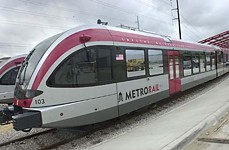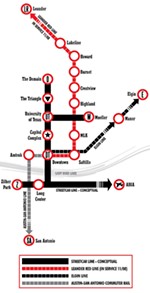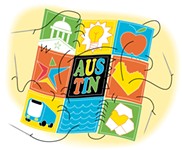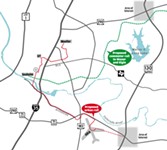One System, Multiple Modes
The map lays out the main lines of the 'multi-modal' regional transportation plans in progress
Fri., June 4, 2004
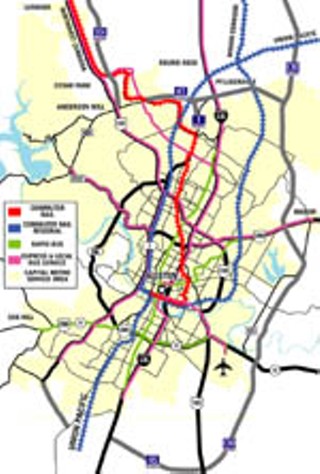
The Central Texas Regional Mobility Authority's toll-road plan and Capital Metro's proposed rail-and-bus plan are, in principle, designed to work together, and all of the roads and rail routes on both are already included in the Capital Area Metropolitan Planning Organization's official long-term transportation plan for the Austin area. Details on the individual proposals:
Road Projects
Except for the brand-new highways in the Central Texas Turnpike Project and U.S. 183-A, all these projects involve adding lanes to existing roadways, tolling those new lanes only, and maintaining free frontage-road access for those who wish to avoid the tolls. Tolls would be collected electronically (eliminating the need for tollbooths and toll plazas) and would, by current estimates, be 12-15 cents a mile.
Central Texas Turnpike Project: These are the toll roads already under construction, or nearly so, that were debated in the 1990s and finally approved in 2002: SH 130, SH 45 North and Southeast, and the MoPac North extension. SH 130, the farthest along, is supposed to open for traffic in 2007. While these aren't technically CTRMA projects, the authority is expected to operate them as toll roads. CAMPO has decreed that SH 45 Southeast cannot be connected to its western twin, and thus all the way through to MoPac, until SH 130 is completed – a response to environmentalists worried about creating a sprawl-inducing I-35 bypass route over the Edwards Aquifer. Also, TxDOT will actually build SH 45 Southeast itself, instead of turning to a design/build franchise partner as it has done with SH 130.
U.S. 183-A: The road the CTRMA was created to build, this bypass around the congested Northwest Corridor from Lakeline Mall to Leander is almost ready to break ground, with the authority reviewing final proposals for construction partners.
U.S. 183 East, Texas 71 East: The longest brand-new projects in the CTRMA plan currently under debate would double capacity on the two main routes to Austin-Bergstrom Airport. These are supposed to be the next CTRMA projects in the pipeline.
MoPac South, U.S. 290/Texas 71 West: These two highly controversial proposals – MoPac over William Cannon, and through the Y in Oak Hill – would toll short segments of these Southwest highways that, neighbors note bitterly, are already under construction (though not fully funded).
Loop 360; U.S. 290 East: The CTRMA proposes rebuilding Loop 360 (within the existing right-of-way, and with environmental controls the existing roadway does not have) as a straight-up public-private partnership, where a franchisee would put up the funds and collect the tolls itself. (The state's last experience with such a deal – the bankrupt Camino Columbia toll road in Laredo – provides examples of what not to do with Loop 360, toll-road backers say.) Such a strategy may also be employed for U.S. 290 East between U.S. 183 and SH 130.
Transit Projects
Compared to the CTRMA plan, Capital Metro's bus-and-rail "vision" is more sketchy, and the agency stresses that its current "All Systems Go!" effort is an attempt to put flesh on its bones. What's currently under discussion:
Commuter rail "urban service": This is the rail line that Cap Metro already owns and uses for freight service, running from Leander to Downtown (actually, all the way from Llano to Giddings) and often calls the Red Line. Station locations are still undetermined, but likely commuter rail stops include Leander, Lakeline Mall, McNeil Junction, Mueller, and Plaza Saltillo, with a Downtown terminus either at the Convention Center or Seaholm Power Plant.
Commuter rail "regional service": This is the label for the long-envisioned Austin-San Antonio passenger system, which would run on the Union Pacific tracks as soon as local players come up with a deal to get the UP out of the way. There's also a potential eastern route – the abandoned rail right-of-way of the MoKan corridor, which was originally to be the route of SH 130.
Rapid bus service: Rapid-bus would use special high tech vehicles that can pre-empt traffic signals, and perhaps also use dedicated bus lanes, to move riders at closer-to-rail speeds. However, rapid bus is also identified as a "near term" solution by Capital Metro; the corridors where it has been designated – up Guadalupe and Lamar, down South Congress, through Mueller, along Ben White – have been light-rail routes in previous Cap Metro planning efforts and may again become rail routes if the commuter-rail system takes off.
Express and local-bus service: Capital Metro insists that any new transit system will include expanded rubber-tire bus service, including more express routes and cross-town routes – both to meet the diverse needs of its constituents and to provide the connectivity to rail (and roads) that will make riding the system easier.
Got something to say on the subject? Send a letter to the editor.





